| 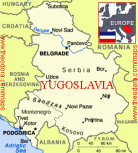 2/21/2008 - AHF monitors developments in Kosovo and calls for autonomy for historic Hungarian minorities in Vojvodina and elsewhere in the Carpathian Basin. With independence of Kosovo and the potential for additional violence, the Federation is concerned over the lack of international attention to the Hungarian minority in the former Yugoslavia: The Hungarians of Vojvodina who lost autonomy by Serbian totalitarian regime of Milosevic. 2/21/2008 - AHF monitors developments in Kosovo and calls for autonomy for historic Hungarian minorities in Vojvodina and elsewhere in the Carpathian Basin. With independence of Kosovo and the potential for additional violence, the Federation is concerned over the lack of international attention to the Hungarian minority in the former Yugoslavia: The Hungarians of Vojvodina who lost autonomy by Serbian totalitarian regime of Milosevic.
In a Letter to the Washington Post, Frank Koszorus called for autonomy for the Hungarian minorities in the Carpathian Basin:
 "International relations is a study of inconsistencies. Romania, Slovakia and Serbia, of course, oppose Kosovo's independence on the basis that states must not be dismembered. Yet these three were the most persistent advocates and beneficiaries of the dismemberment of Hungary following the First World War. They opposed plebiscites for the affected populations and instead grabbed as much territory as they could. Romania, for example, wrested Transylvania from Hungary, a territory larger than that retained by Hungary. Suddenly, over 1,704,852 ethnic Hungarians found themselves under Romanian rule. The situation was similar in Slovakia and Yugoslavia. "International relations is a study of inconsistencies. Romania, Slovakia and Serbia, of course, oppose Kosovo's independence on the basis that states must not be dismembered. Yet these three were the most persistent advocates and beneficiaries of the dismemberment of Hungary following the First World War. They opposed plebiscites for the affected populations and instead grabbed as much territory as they could. Romania, for example, wrested Transylvania from Hungary, a territory larger than that retained by Hungary. Suddenly, over 1,704,852 ethnic Hungarians found themselves under Romanian rule. The situation was similar in Slovakia and Yugoslavia.
While Kosovars and other nations of Central and Eastern Europe have realized their aspirations for self-determination, the Hungarian minorities are still denied the right of autonomy within existing borders. Romania, Slovakia and Serbia ought to be in the forefront of granting their Hungarian historical communities minority rights. Such enlightened and democratic policies would be consistent with their opposition to external self-determination."
In a parallel letter to the Washington Times in reaction to an editorial by Dale McFeatters congratulating Kosovo on its newfound independence:
"Dale McFeatters is right to congratulate Kosovars on their independence [Kosovo goes out on its own, February 20, 2008]. Europe appears to be pursuing two contradictory policies -- integration and disintegration. Closer examination reveals that both occurrences are synergistic and promote democracy. As nations govern themselves, they simultaneously choose to become part of the larger multilateral European Union. This is the new Europe which should be welcomed by all who wish to advance security, stability and democracy on a continent that not so long ago was wracked by violence and two isms -- Nazism and Communism -- that proved to be scourges of mankind and civilization.
Kosovo's declaration of independence from Serbia is the most recent nail in the coffin of the old Europe that was ill advisedly crafted by vengeful and short-sighted peacemakers following the First World War and reinforced by the post World War II arrangements. That order unceremoniously and almost instantaneously collapsed with the end of the Cold War. Nations throughout the region seized the opportunity to realize their long-cherished hopes to exercise external self-determination. For example, Croatians, and Slovenians escaped Serbia's stranglehold, albeit only after military conflict. Montenegro is now independent as is Kosovo. Slovaks broke away from Prague in the peaceful velvet divorce of 1993.
Ironically, none of these nations can realistically point to any greater historically better grounded basis for their aspirations than the languishing indigenous Hungarian communities in the Central Europe. While these other nations of the region exercised the right of self-determination and drastically changed the map of Central and Eastern Europe, the Hungarian historical communities continue to live as minorities in the newly divided successor states.
The issue is not their status but that they are still living with the stifling status quo that threatens their culture, as they are denied a host of minority rights and the right to autonomy ? cultural or territorial. Even the current post-communist Romanian government, for example, refuses to restore the Hungarian language university in Cluj (Kolozsvar) that had been forcibly eliminated by Ceausescu. Along with Slovakia, it rejects its Hungarian minority's autonomy proposals that would ensure local self-governance, not independence or revisionism, and the protection of that minority's unique culture and ethnic identity.
The new Europe should finally embrace this minority and its democratically asserted quest for collective rights and autonomy."
[< Back to News from the Former Yugoslavia]
[<
back to all AHF news]
|
Why
so many Hungarians across the border?
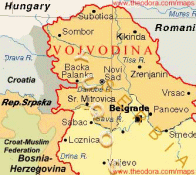 Vojvodina
was part of Hungary since 896 AD and was awarded to the newly formed Yugoslavia
by the French in the "Treaty" of
Trianon in 1920 when Hungary lost 2/3 of her territory and 1/3 of
her Hungarian population. Large scale evictions, fear of self-reporting,
and other Serb progroms, have left only about 300-350,000 ethnic Hungarians
in the province. Some, however, estimate this number to be double that
since many fear self-reporting as Hungarian exposes them to risk Vojvodina
was part of Hungary since 896 AD and was awarded to the newly formed Yugoslavia
by the French in the "Treaty" of
Trianon in 1920 when Hungary lost 2/3 of her territory and 1/3 of
her Hungarian population. Large scale evictions, fear of self-reporting,
and other Serb progroms, have left only about 300-350,000 ethnic Hungarians
in the province. Some, however, estimate this number to be double that
since many fear self-reporting as Hungarian exposes them to risk
The American-Hungarian community
is increasingly concerned by the recent outbreak of violence in Vojvodina.
"Ethnic
Cleansing" in action
How
did this region become part of Yugoslavia? Read "The Conflict in
the Former Yugoslavia and Autonomous Region of Vojvodina, and the Need
for a More Coherent U.S. Foreign Policy" on The
Hungary Page and refer to the following demographic maps comparing
Vojvodina in 1910 and 1991. Note the decline seen here in Hungarian population
does NOT take into consideration the Balkan conflicts and the significant
escalation of atrocities against Hungarians over the last decade:
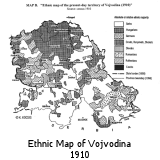
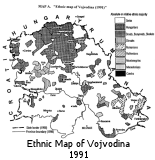
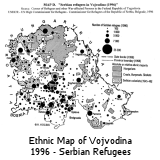
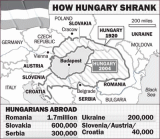
Click
images for larger version
AHF Related Links
External
Links
Read additional
Stories in HUNGARIAN
- 10/14/2005 - Koszorús Ferencet
idézi az újvidéki Magyar Szó: „NEMZETKÖZIESÍTSÜNK”-E
VAGY SEM: Tojástánc [tovább]
- 6/10/2005 - A MAGYAROK CSAK TÁNCOLJANAK:
Egybehangolt lejáratási kampány a VMSZ ellen [tovább]

These are .PDF files.
If you do not have the free
Adobe Reader, get it by clicking the icon

-
"Magyarellenes
Falfirkák Szabadkán,"
MAGYAR SZÓ, Novi Sad/Újvidék (in Hungarian) 4/3/2004
-
"Temetőgyalázás,"
MAGYAR SZÓ, Novi Sad/Újvidék (in Hungarian)
3/29/2004
- See the International
Crisis Group Report on Serbia from July 1994: Serbia's Changing
Political Landscape, a Briefing. An excerpt regarding Serb violence:
"Some Serbs in Vojvodina are demonstrating behaviour reminiscent
of that which they so frequently and vociferouslt condemn the Kosovo
Albanians."

 Monica
Seles - (b. in the Vajdaság (Vojvodina), the Hungarian region
that was given to Serbia/Yugoslavia.) Monica
Seles - (b. in the Vajdaság (Vojvodina), the Hungarian region
that was given to Serbia/Yugoslavia.)
Tennis Superstar - She has won 9 Grand Slam
singles titles and bronze in Sydney 2000!
Seles
(pronounced sell-esh and spelled Szeles Monika) won the European junior
championship at the age of ten. Born to a Hungarian family in the former
Hungarian province of Vojvodina, she moved to the United States in 1986,
and in 1989 turned professional. In 1990 she won her first French Open,
and in each of the following two years she won the Australian, United
States, and French opens. Seles won the Australian Open in early 1993,
but later that year, while resting between sets during a tournament in
Hamburg, Germany, she was stabbed by a spectator. The incident caused
Seles to withdraw from competition in 1993 and 1994. Seles returned to
competition in 1995 and won the initial tournament of her comeback, the
Canadian Open. In 1996 she again won the Australian Open.
Monica
is a fierce competitor and is still going strong into the new millennium
including winning the Bronze medal at the 2000 Sydney Olympics!
See:
http://www.angelfire.com/tx/MONICASELES/index2.html
or a small bio: http://www.bartleby.com/65/se/SelesMoni.html
|



